Detailed Report: Identification of Campylobacter Species Analysis
VerifiedAdded on 2022/11/13
|17
|4158
|129
Report
AI Summary
This report comprehensively examines the identification of Campylobacter species, a significant cause of bacterial gastroenteritis. It begins with an overview of the characteristics of Campylobacter, including its morphology, growth requirements, and the diseases it causes, particularly Campylobacter jejuni and Campylobacter coli. The report then delves into the principles of identification, detailing both conventional culture-based methods, such as Gram staining and biochemical tests, and advanced molecular techniques. The discussion covers the media used for isolation, Gram staining procedures, and the application of MALDI-TOF mass spectrometry, which offers rapid and accurate species identification. Furthermore, the report explores rapid molecular methods like PCR, PFGE, MLST and immune-based assays, highlighting their enhanced diagnostic capabilities. The report also addresses safety considerations and concludes by emphasizing the importance of rapid and accurate identification in preventing and controlling campylobacteriosis. The document provides a detailed analysis of various identification techniques and their applications in clinical and environmental settings.
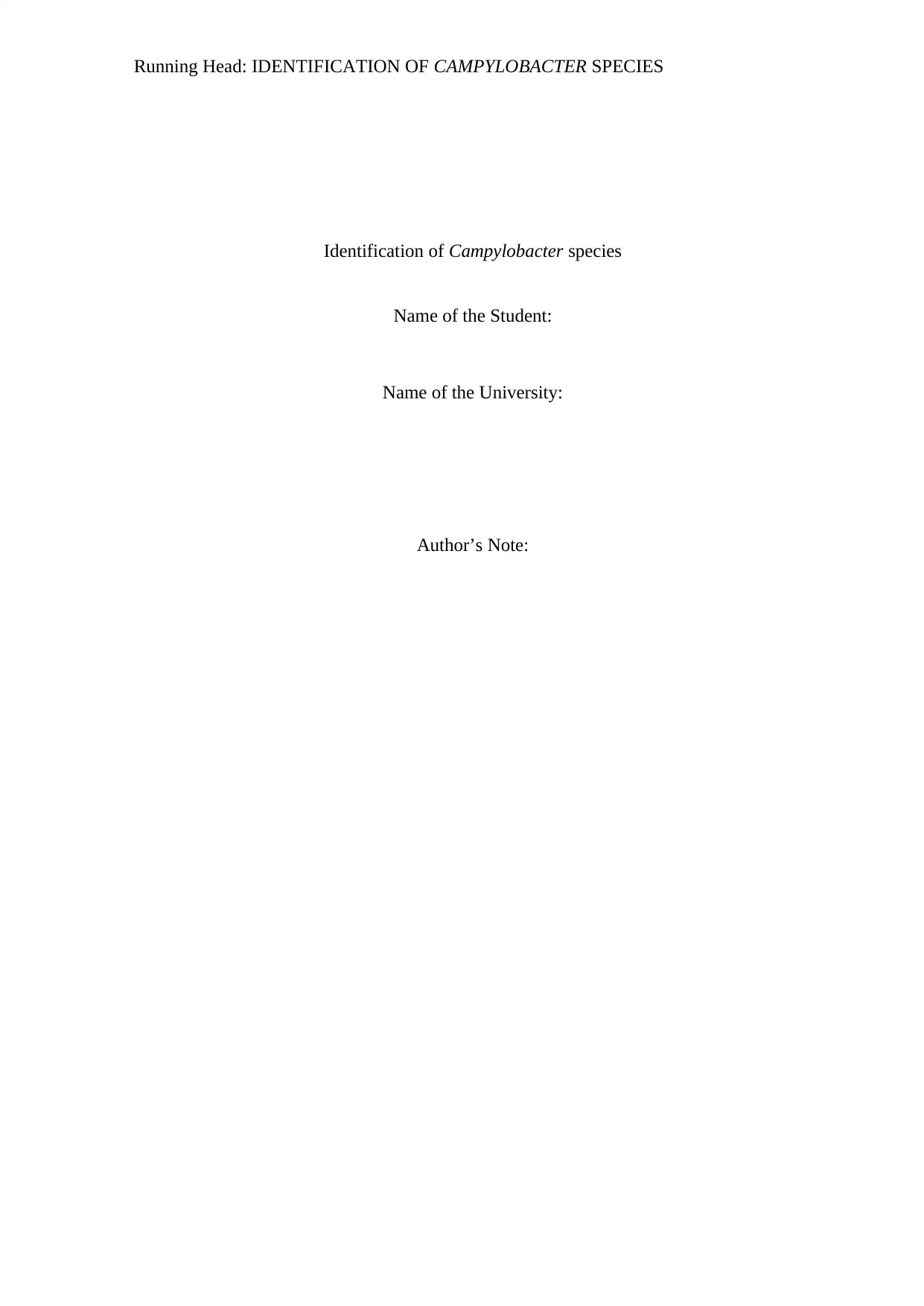
Running Head: IDENTIFICATION OF CAMPYLOBACTER SPECIES
Identification of Campylobacter species
Name of the Student:
Name of the University:
Author’s Note:
Identification of Campylobacter species
Name of the Student:
Name of the University:
Author’s Note:
Paraphrase This Document
Need a fresh take? Get an instant paraphrase of this document with our AI Paraphraser
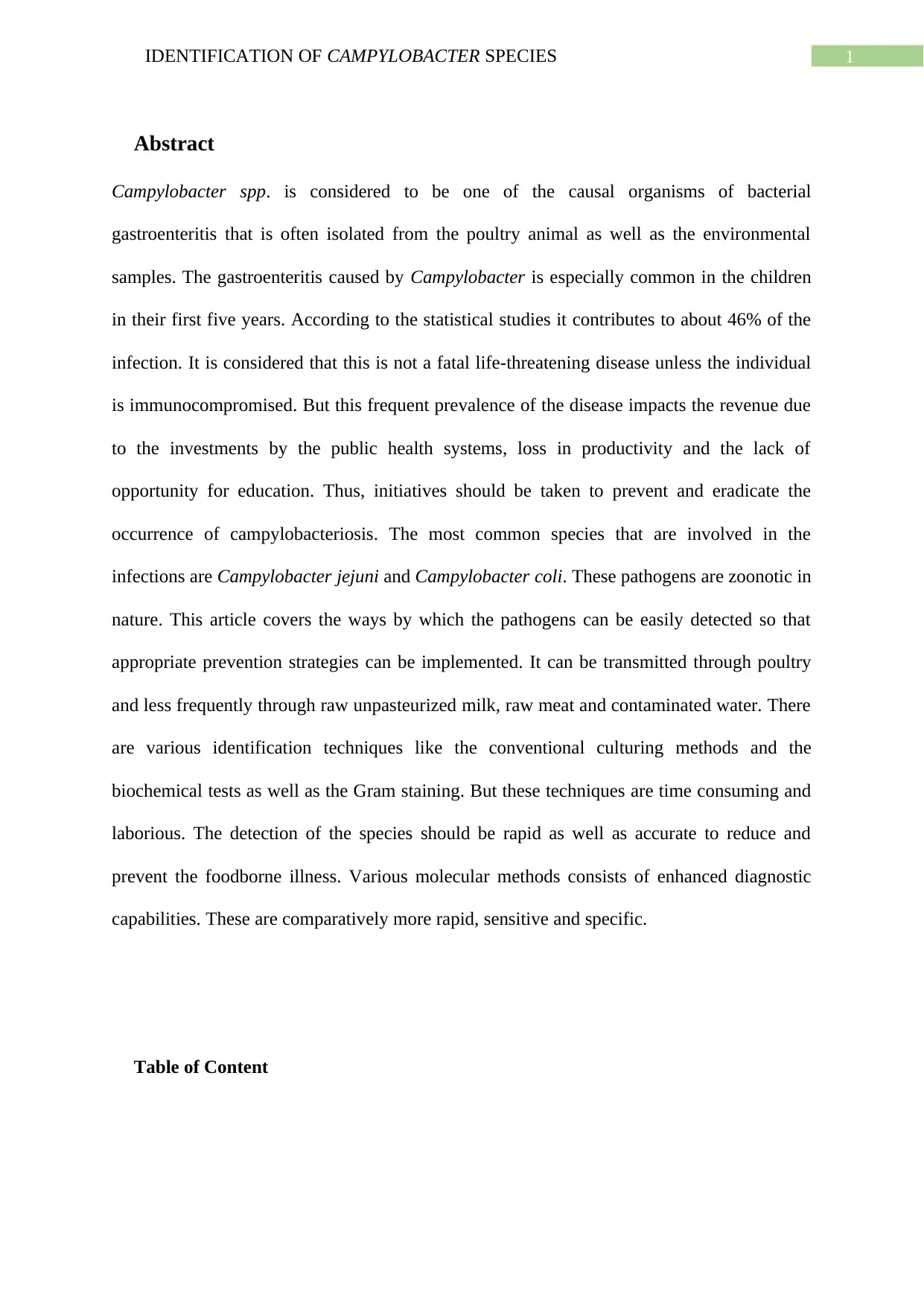
1IDENTIFICATION OF CAMPYLOBACTER SPECIES
Abstract
Campylobacter spp. is considered to be one of the causal organisms of bacterial
gastroenteritis that is often isolated from the poultry animal as well as the environmental
samples. The gastroenteritis caused by Campylobacter is especially common in the children
in their first five years. According to the statistical studies it contributes to about 46% of the
infection. It is considered that this is not a fatal life-threatening disease unless the individual
is immunocompromised. But this frequent prevalence of the disease impacts the revenue due
to the investments by the public health systems, loss in productivity and the lack of
opportunity for education. Thus, initiatives should be taken to prevent and eradicate the
occurrence of campylobacteriosis. The most common species that are involved in the
infections are Campylobacter jejuni and Campylobacter coli. These pathogens are zoonotic in
nature. This article covers the ways by which the pathogens can be easily detected so that
appropriate prevention strategies can be implemented. It can be transmitted through poultry
and less frequently through raw unpasteurized milk, raw meat and contaminated water. There
are various identification techniques like the conventional culturing methods and the
biochemical tests as well as the Gram staining. But these techniques are time consuming and
laborious. The detection of the species should be rapid as well as accurate to reduce and
prevent the foodborne illness. Various molecular methods consists of enhanced diagnostic
capabilities. These are comparatively more rapid, sensitive and specific.
Table of Content
Abstract
Campylobacter spp. is considered to be one of the causal organisms of bacterial
gastroenteritis that is often isolated from the poultry animal as well as the environmental
samples. The gastroenteritis caused by Campylobacter is especially common in the children
in their first five years. According to the statistical studies it contributes to about 46% of the
infection. It is considered that this is not a fatal life-threatening disease unless the individual
is immunocompromised. But this frequent prevalence of the disease impacts the revenue due
to the investments by the public health systems, loss in productivity and the lack of
opportunity for education. Thus, initiatives should be taken to prevent and eradicate the
occurrence of campylobacteriosis. The most common species that are involved in the
infections are Campylobacter jejuni and Campylobacter coli. These pathogens are zoonotic in
nature. This article covers the ways by which the pathogens can be easily detected so that
appropriate prevention strategies can be implemented. It can be transmitted through poultry
and less frequently through raw unpasteurized milk, raw meat and contaminated water. There
are various identification techniques like the conventional culturing methods and the
biochemical tests as well as the Gram staining. But these techniques are time consuming and
laborious. The detection of the species should be rapid as well as accurate to reduce and
prevent the foodborne illness. Various molecular methods consists of enhanced diagnostic
capabilities. These are comparatively more rapid, sensitive and specific.
Table of Content
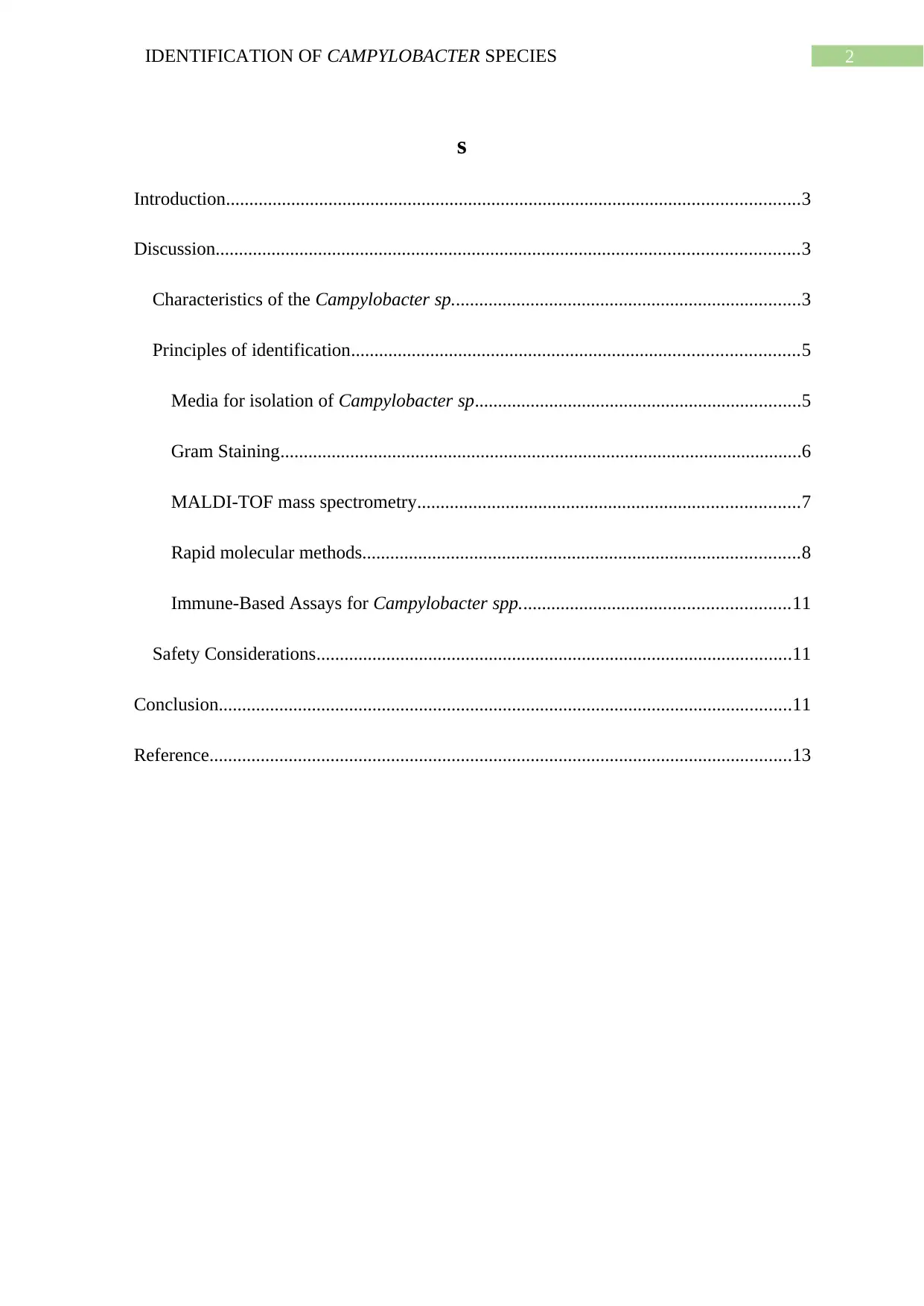
2IDENTIFICATION OF CAMPYLOBACTER SPECIES
s
Introduction...........................................................................................................................3
Discussion.............................................................................................................................3
Characteristics of the Campylobacter sp...........................................................................3
Principles of identification................................................................................................5
Media for isolation of Campylobacter sp......................................................................5
Gram Staining................................................................................................................6
MALDI-TOF mass spectrometry..................................................................................7
Rapid molecular methods..............................................................................................8
Immune-Based Assays for Campylobacter spp..........................................................11
Safety Considerations......................................................................................................11
Conclusion...........................................................................................................................11
Reference.............................................................................................................................13
s
Introduction...........................................................................................................................3
Discussion.............................................................................................................................3
Characteristics of the Campylobacter sp...........................................................................3
Principles of identification................................................................................................5
Media for isolation of Campylobacter sp......................................................................5
Gram Staining................................................................................................................6
MALDI-TOF mass spectrometry..................................................................................7
Rapid molecular methods..............................................................................................8
Immune-Based Assays for Campylobacter spp..........................................................11
Safety Considerations......................................................................................................11
Conclusion...........................................................................................................................11
Reference.............................................................................................................................13
⊘ This is a preview!⊘
Do you want full access?
Subscribe today to unlock all pages.

Trusted by 1+ million students worldwide
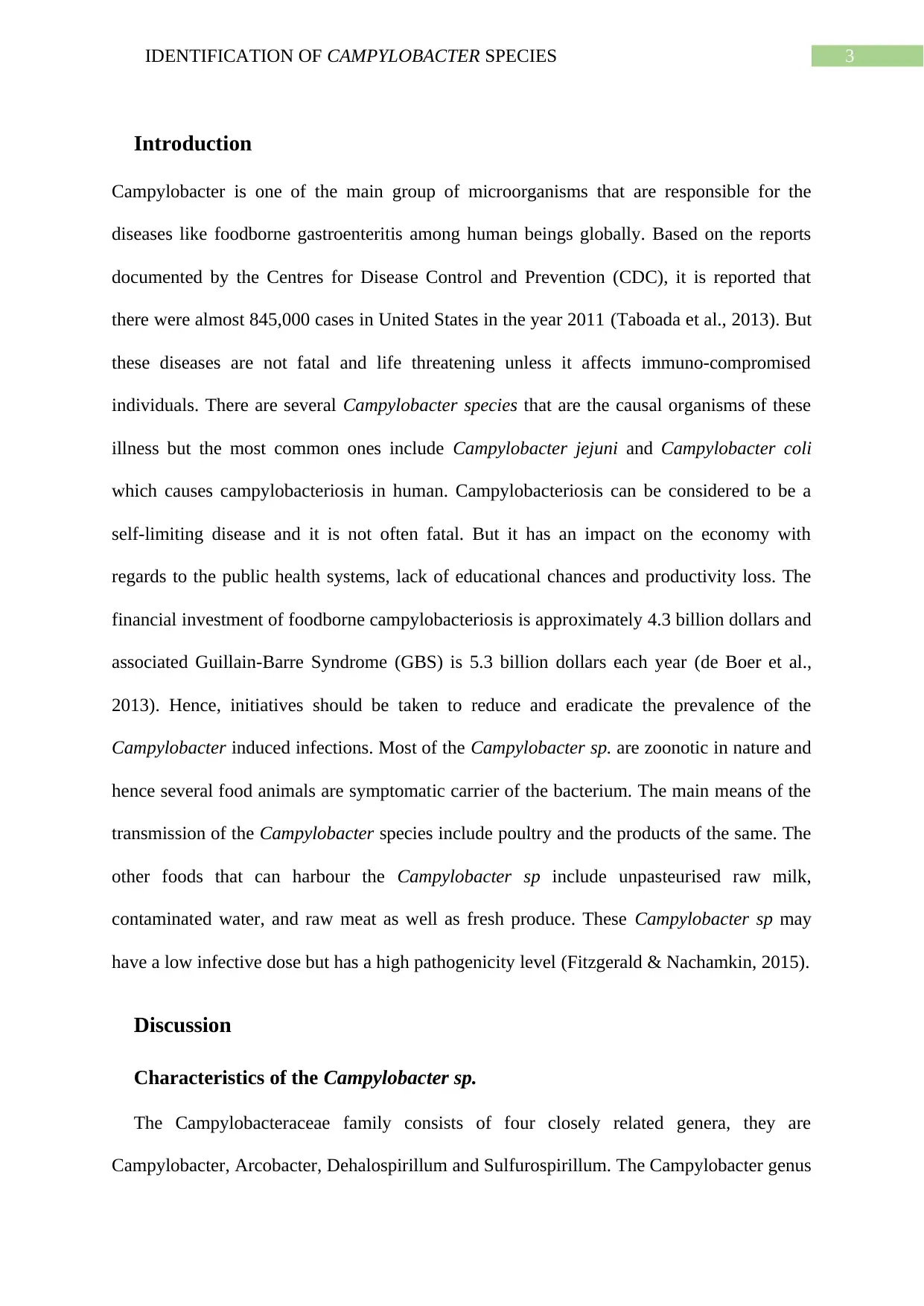
3IDENTIFICATION OF CAMPYLOBACTER SPECIES
Introduction
Campylobacter is one of the main group of microorganisms that are responsible for the
diseases like foodborne gastroenteritis among human beings globally. Based on the reports
documented by the Centres for Disease Control and Prevention (CDC), it is reported that
there were almost 845,000 cases in United States in the year 2011 (Taboada et al., 2013). But
these diseases are not fatal and life threatening unless it affects immuno-compromised
individuals. There are several Campylobacter species that are the causal organisms of these
illness but the most common ones include Campylobacter jejuni and Campylobacter coli
which causes campylobacteriosis in human. Campylobacteriosis can be considered to be a
self-limiting disease and it is not often fatal. But it has an impact on the economy with
regards to the public health systems, lack of educational chances and productivity loss. The
financial investment of foodborne campylobacteriosis is approximately 4.3 billion dollars and
associated Guillain-Barre Syndrome (GBS) is 5.3 billion dollars each year (de Boer et al.,
2013). Hence, initiatives should be taken to reduce and eradicate the prevalence of the
Campylobacter induced infections. Most of the Campylobacter sp. are zoonotic in nature and
hence several food animals are symptomatic carrier of the bacterium. The main means of the
transmission of the Campylobacter species include poultry and the products of the same. The
other foods that can harbour the Campylobacter sp include unpasteurised raw milk,
contaminated water, and raw meat as well as fresh produce. These Campylobacter sp may
have a low infective dose but has a high pathogenicity level (Fitzgerald & Nachamkin, 2015).
Discussion
Characteristics of the Campylobacter sp.
The Campylobacteraceae family consists of four closely related genera, they are
Campylobacter, Arcobacter, Dehalospirillum and Sulfurospirillum. The Campylobacter genus
Introduction
Campylobacter is one of the main group of microorganisms that are responsible for the
diseases like foodborne gastroenteritis among human beings globally. Based on the reports
documented by the Centres for Disease Control and Prevention (CDC), it is reported that
there were almost 845,000 cases in United States in the year 2011 (Taboada et al., 2013). But
these diseases are not fatal and life threatening unless it affects immuno-compromised
individuals. There are several Campylobacter species that are the causal organisms of these
illness but the most common ones include Campylobacter jejuni and Campylobacter coli
which causes campylobacteriosis in human. Campylobacteriosis can be considered to be a
self-limiting disease and it is not often fatal. But it has an impact on the economy with
regards to the public health systems, lack of educational chances and productivity loss. The
financial investment of foodborne campylobacteriosis is approximately 4.3 billion dollars and
associated Guillain-Barre Syndrome (GBS) is 5.3 billion dollars each year (de Boer et al.,
2013). Hence, initiatives should be taken to reduce and eradicate the prevalence of the
Campylobacter induced infections. Most of the Campylobacter sp. are zoonotic in nature and
hence several food animals are symptomatic carrier of the bacterium. The main means of the
transmission of the Campylobacter species include poultry and the products of the same. The
other foods that can harbour the Campylobacter sp include unpasteurised raw milk,
contaminated water, and raw meat as well as fresh produce. These Campylobacter sp may
have a low infective dose but has a high pathogenicity level (Fitzgerald & Nachamkin, 2015).
Discussion
Characteristics of the Campylobacter sp.
The Campylobacteraceae family consists of four closely related genera, they are
Campylobacter, Arcobacter, Dehalospirillum and Sulfurospirillum. The Campylobacter genus
Paraphrase This Document
Need a fresh take? Get an instant paraphrase of this document with our AI Paraphraser
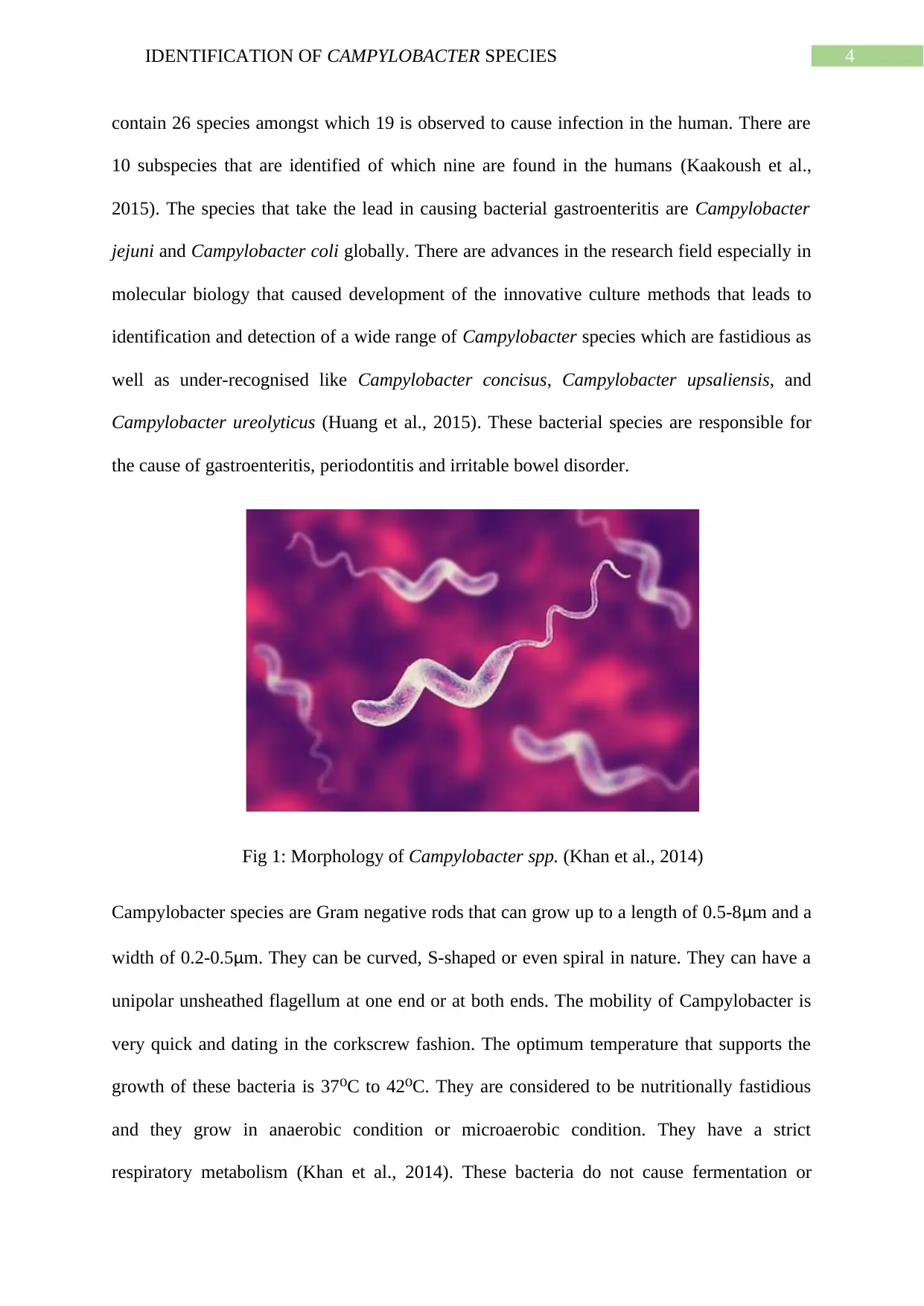
4IDENTIFICATION OF CAMPYLOBACTER SPECIES
contain 26 species amongst which 19 is observed to cause infection in the human. There are
10 subspecies that are identified of which nine are found in the humans (Kaakoush et al.,
2015). The species that take the lead in causing bacterial gastroenteritis are Campylobacter
jejuni and Campylobacter coli globally. There are advances in the research field especially in
molecular biology that caused development of the innovative culture methods that leads to
identification and detection of a wide range of Campylobacter species which are fastidious as
well as under-recognised like Campylobacter concisus, Campylobacter upsaliensis, and
Campylobacter ureolyticus (Huang et al., 2015). These bacterial species are responsible for
the cause of gastroenteritis, periodontitis and irritable bowel disorder.
Fig 1: Morphology of Campylobacter spp. (Khan et al., 2014)
Campylobacter species are Gram negative rods that can grow up to a length of 0.5-8μm and a
width of 0.2-0.5μm. They can be curved, S-shaped or even spiral in nature. They can have a
unipolar unsheathed flagellum at one end or at both ends. The mobility of Campylobacter is
very quick and dating in the corkscrew fashion. The optimum temperature that supports the
growth of these bacteria is 37 C to 42 C. They are considered to be nutritionally fastidious⁰ ⁰
and they grow in anaerobic condition or microaerobic condition. They have a strict
respiratory metabolism (Khan et al., 2014). These bacteria do not cause fermentation or
contain 26 species amongst which 19 is observed to cause infection in the human. There are
10 subspecies that are identified of which nine are found in the humans (Kaakoush et al.,
2015). The species that take the lead in causing bacterial gastroenteritis are Campylobacter
jejuni and Campylobacter coli globally. There are advances in the research field especially in
molecular biology that caused development of the innovative culture methods that leads to
identification and detection of a wide range of Campylobacter species which are fastidious as
well as under-recognised like Campylobacter concisus, Campylobacter upsaliensis, and
Campylobacter ureolyticus (Huang et al., 2015). These bacterial species are responsible for
the cause of gastroenteritis, periodontitis and irritable bowel disorder.
Fig 1: Morphology of Campylobacter spp. (Khan et al., 2014)
Campylobacter species are Gram negative rods that can grow up to a length of 0.5-8μm and a
width of 0.2-0.5μm. They can be curved, S-shaped or even spiral in nature. They can have a
unipolar unsheathed flagellum at one end or at both ends. The mobility of Campylobacter is
very quick and dating in the corkscrew fashion. The optimum temperature that supports the
growth of these bacteria is 37 C to 42 C. They are considered to be nutritionally fastidious⁰ ⁰
and they grow in anaerobic condition or microaerobic condition. They have a strict
respiratory metabolism (Khan et al., 2014). These bacteria do not cause fermentation or
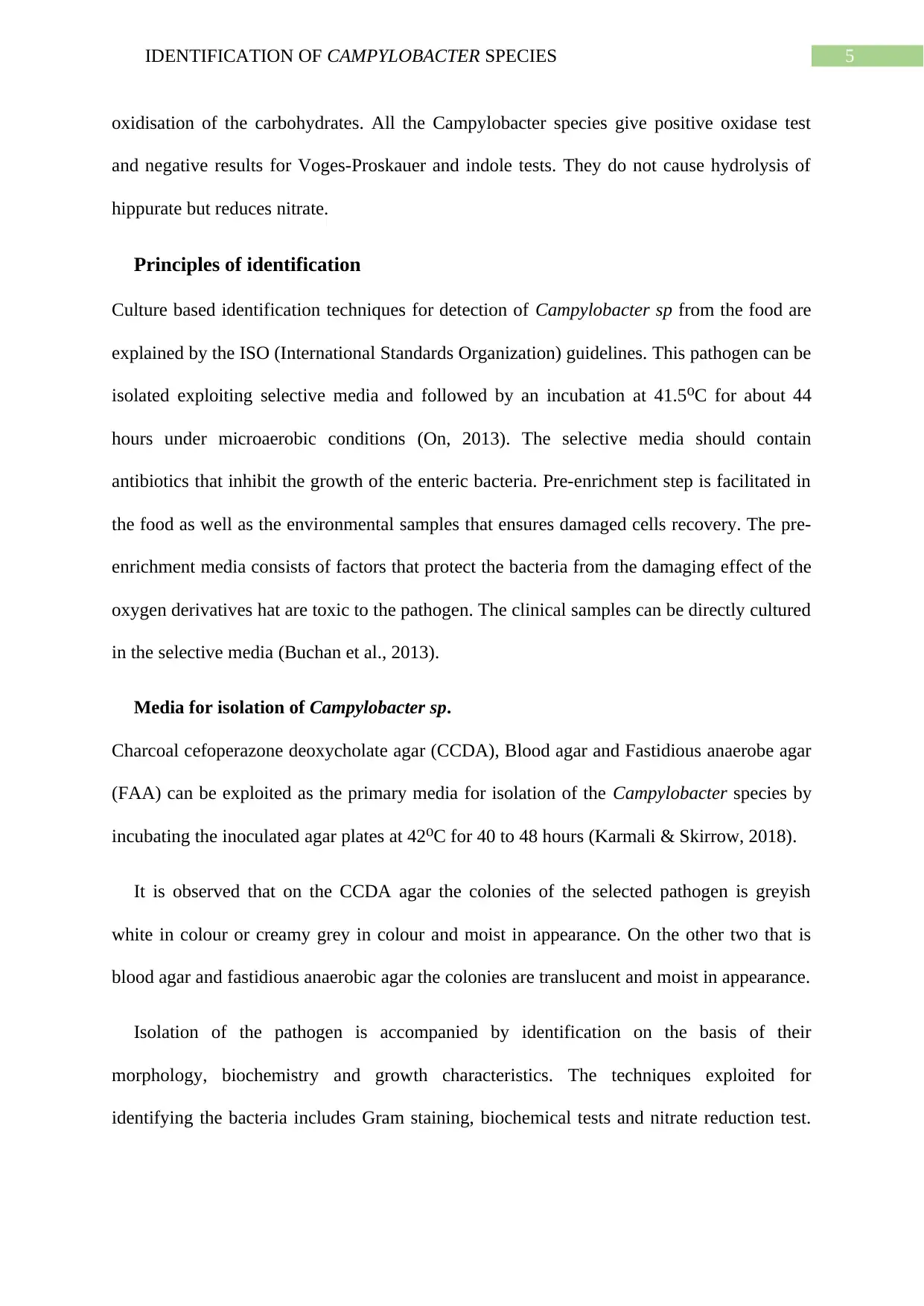
5IDENTIFICATION OF CAMPYLOBACTER SPECIES
oxidisation of the carbohydrates. All the Campylobacter species give positive oxidase test
and negative results for Voges-Proskauer and indole tests. They do not cause hydrolysis of
hippurate but reduces nitrate.
Principles of identification
Culture based identification techniques for detection of Campylobacter sp from the food are
explained by the ISO (International Standards Organization) guidelines. This pathogen can be
isolated exploiting selective media and followed by an incubation at 41.5⁰C for about 44
hours under microaerobic conditions (On, 2013). The selective media should contain
antibiotics that inhibit the growth of the enteric bacteria. Pre-enrichment step is facilitated in
the food as well as the environmental samples that ensures damaged cells recovery. The pre-
enrichment media consists of factors that protect the bacteria from the damaging effect of the
oxygen derivatives hat are toxic to the pathogen. The clinical samples can be directly cultured
in the selective media (Buchan et al., 2013).
Media for isolation of Campylobacter sp.
Charcoal cefoperazone deoxycholate agar (CCDA), Blood agar and Fastidious anaerobe agar
(FAA) can be exploited as the primary media for isolation of the Campylobacter species by
incubating the inoculated agar plates at 42⁰C for 40 to 48 hours (Karmali & Skirrow, 2018).
It is observed that on the CCDA agar the colonies of the selected pathogen is greyish
white in colour or creamy grey in colour and moist in appearance. On the other two that is
blood agar and fastidious anaerobic agar the colonies are translucent and moist in appearance.
Isolation of the pathogen is accompanied by identification on the basis of their
morphology, biochemistry and growth characteristics. The techniques exploited for
identifying the bacteria includes Gram staining, biochemical tests and nitrate reduction test.
oxidisation of the carbohydrates. All the Campylobacter species give positive oxidase test
and negative results for Voges-Proskauer and indole tests. They do not cause hydrolysis of
hippurate but reduces nitrate.
Principles of identification
Culture based identification techniques for detection of Campylobacter sp from the food are
explained by the ISO (International Standards Organization) guidelines. This pathogen can be
isolated exploiting selective media and followed by an incubation at 41.5⁰C for about 44
hours under microaerobic conditions (On, 2013). The selective media should contain
antibiotics that inhibit the growth of the enteric bacteria. Pre-enrichment step is facilitated in
the food as well as the environmental samples that ensures damaged cells recovery. The pre-
enrichment media consists of factors that protect the bacteria from the damaging effect of the
oxygen derivatives hat are toxic to the pathogen. The clinical samples can be directly cultured
in the selective media (Buchan et al., 2013).
Media for isolation of Campylobacter sp.
Charcoal cefoperazone deoxycholate agar (CCDA), Blood agar and Fastidious anaerobe agar
(FAA) can be exploited as the primary media for isolation of the Campylobacter species by
incubating the inoculated agar plates at 42⁰C for 40 to 48 hours (Karmali & Skirrow, 2018).
It is observed that on the CCDA agar the colonies of the selected pathogen is greyish
white in colour or creamy grey in colour and moist in appearance. On the other two that is
blood agar and fastidious anaerobic agar the colonies are translucent and moist in appearance.
Isolation of the pathogen is accompanied by identification on the basis of their
morphology, biochemistry and growth characteristics. The techniques exploited for
identifying the bacteria includes Gram staining, biochemical tests and nitrate reduction test.
⊘ This is a preview!⊘
Do you want full access?
Subscribe today to unlock all pages.

Trusted by 1+ million students worldwide
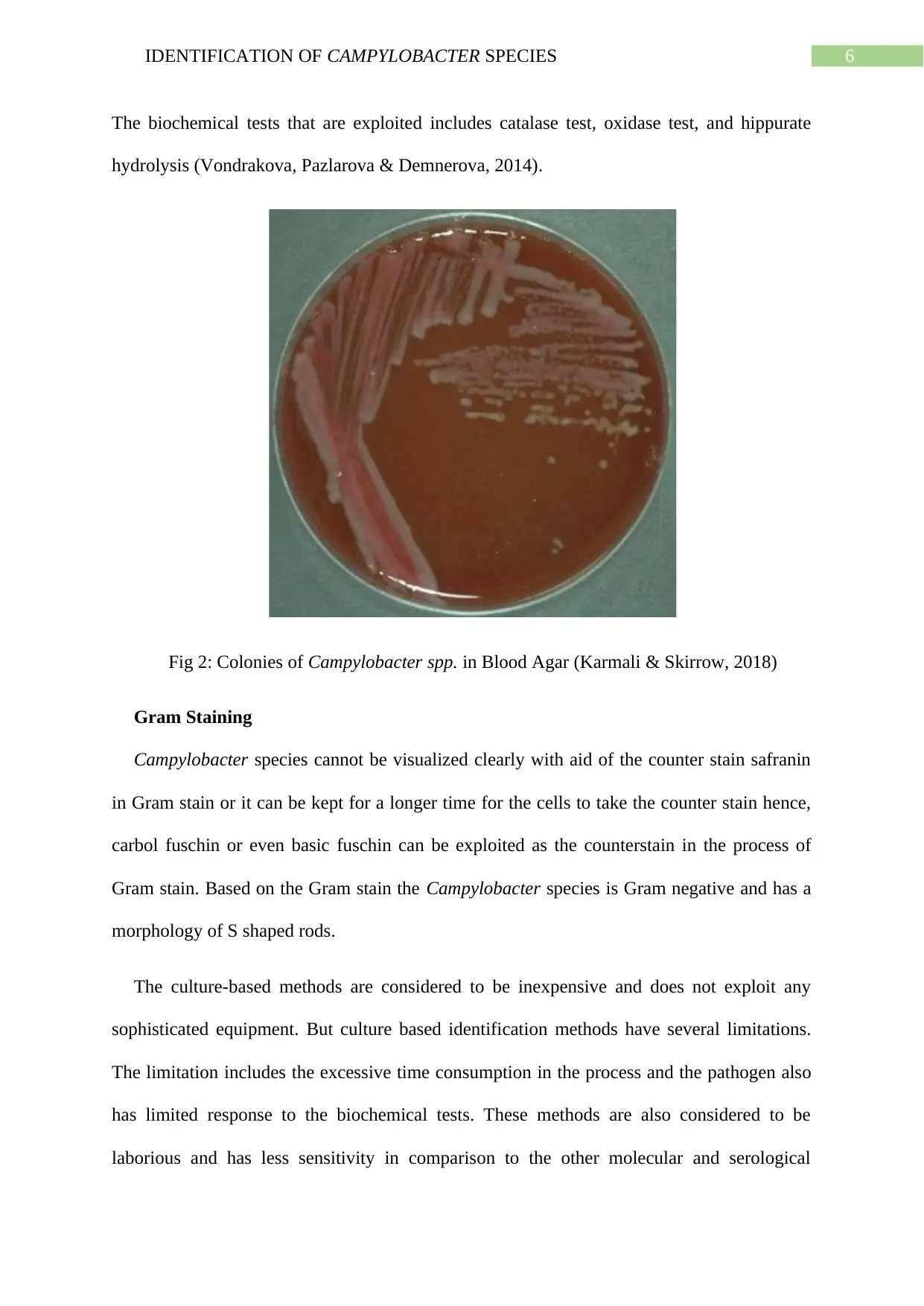
6IDENTIFICATION OF CAMPYLOBACTER SPECIES
The biochemical tests that are exploited includes catalase test, oxidase test, and hippurate
hydrolysis (Vondrakova, Pazlarova & Demnerova, 2014).
Fig 2: Colonies of Campylobacter spp. in Blood Agar (Karmali & Skirrow, 2018)
Gram Staining
Campylobacter species cannot be visualized clearly with aid of the counter stain safranin
in Gram stain or it can be kept for a longer time for the cells to take the counter stain hence,
carbol fuschin or even basic fuschin can be exploited as the counterstain in the process of
Gram stain. Based on the Gram stain the Campylobacter species is Gram negative and has a
morphology of S shaped rods.
The culture-based methods are considered to be inexpensive and does not exploit any
sophisticated equipment. But culture based identification methods have several limitations.
The limitation includes the excessive time consumption in the process and the pathogen also
has limited response to the biochemical tests. These methods are also considered to be
laborious and has less sensitivity in comparison to the other molecular and serological
The biochemical tests that are exploited includes catalase test, oxidase test, and hippurate
hydrolysis (Vondrakova, Pazlarova & Demnerova, 2014).
Fig 2: Colonies of Campylobacter spp. in Blood Agar (Karmali & Skirrow, 2018)
Gram Staining
Campylobacter species cannot be visualized clearly with aid of the counter stain safranin
in Gram stain or it can be kept for a longer time for the cells to take the counter stain hence,
carbol fuschin or even basic fuschin can be exploited as the counterstain in the process of
Gram stain. Based on the Gram stain the Campylobacter species is Gram negative and has a
morphology of S shaped rods.
The culture-based methods are considered to be inexpensive and does not exploit any
sophisticated equipment. But culture based identification methods have several limitations.
The limitation includes the excessive time consumption in the process and the pathogen also
has limited response to the biochemical tests. These methods are also considered to be
laborious and has less sensitivity in comparison to the other molecular and serological
Paraphrase This Document
Need a fresh take? Get an instant paraphrase of this document with our AI Paraphraser
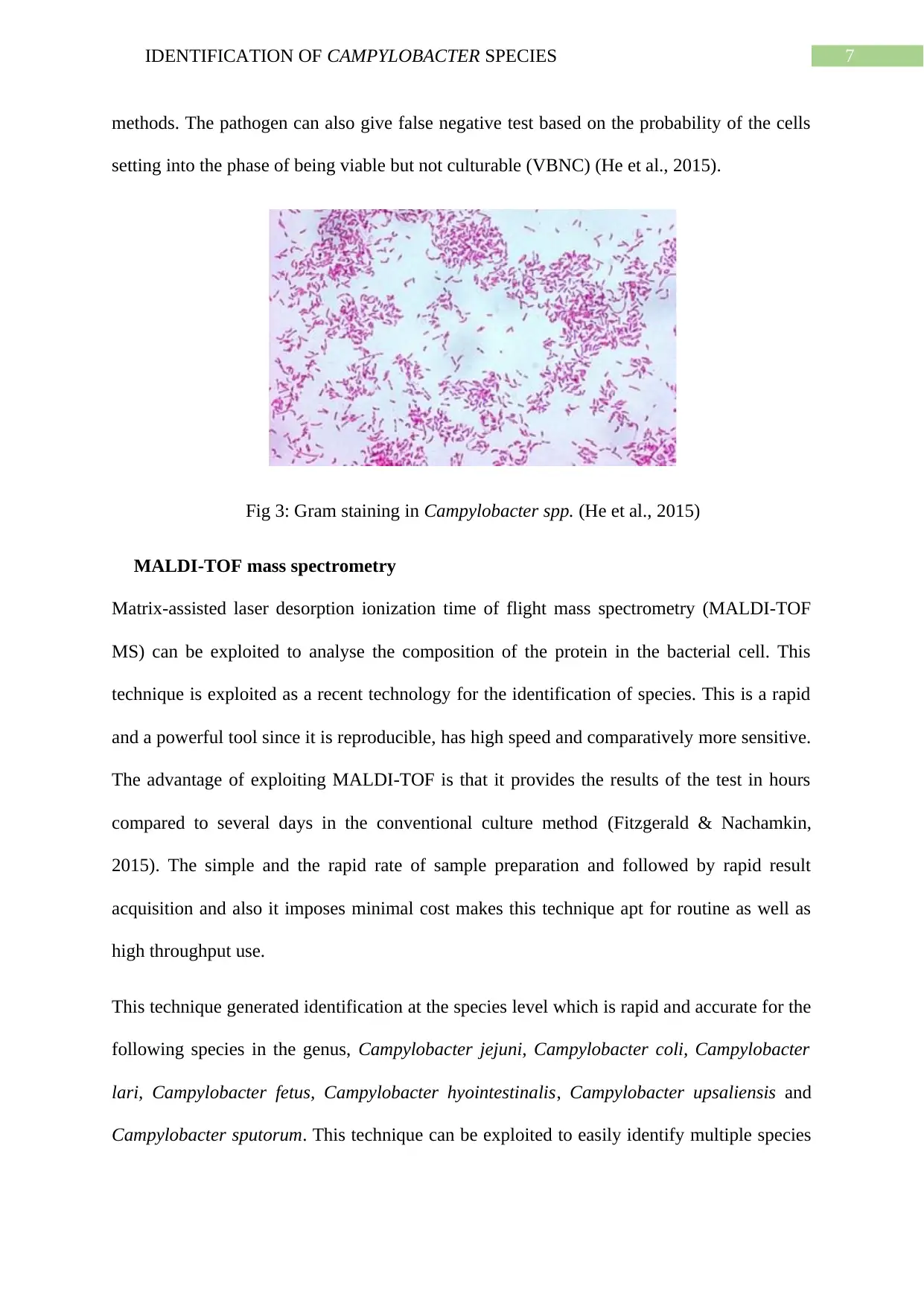
7IDENTIFICATION OF CAMPYLOBACTER SPECIES
methods. The pathogen can also give false negative test based on the probability of the cells
setting into the phase of being viable but not culturable (VBNC) (He et al., 2015).
Fig 3: Gram staining in Campylobacter spp. (He et al., 2015)
MALDI-TOF mass spectrometry
Matrix-assisted laser desorption ionization time of flight mass spectrometry (MALDI-TOF
MS) can be exploited to analyse the composition of the protein in the bacterial cell. This
technique is exploited as a recent technology for the identification of species. This is a rapid
and a powerful tool since it is reproducible, has high speed and comparatively more sensitive.
The advantage of exploiting MALDI-TOF is that it provides the results of the test in hours
compared to several days in the conventional culture method (Fitzgerald & Nachamkin,
2015). The simple and the rapid rate of sample preparation and followed by rapid result
acquisition and also it imposes minimal cost makes this technique apt for routine as well as
high throughput use.
This technique generated identification at the species level which is rapid and accurate for the
following species in the genus, Campylobacter jejuni, Campylobacter coli, Campylobacter
lari, Campylobacter fetus, Campylobacter hyointestinalis, Campylobacter upsaliensis and
Campylobacter sputorum. This technique can be exploited to easily identify multiple species
methods. The pathogen can also give false negative test based on the probability of the cells
setting into the phase of being viable but not culturable (VBNC) (He et al., 2015).
Fig 3: Gram staining in Campylobacter spp. (He et al., 2015)
MALDI-TOF mass spectrometry
Matrix-assisted laser desorption ionization time of flight mass spectrometry (MALDI-TOF
MS) can be exploited to analyse the composition of the protein in the bacterial cell. This
technique is exploited as a recent technology for the identification of species. This is a rapid
and a powerful tool since it is reproducible, has high speed and comparatively more sensitive.
The advantage of exploiting MALDI-TOF is that it provides the results of the test in hours
compared to several days in the conventional culture method (Fitzgerald & Nachamkin,
2015). The simple and the rapid rate of sample preparation and followed by rapid result
acquisition and also it imposes minimal cost makes this technique apt for routine as well as
high throughput use.
This technique generated identification at the species level which is rapid and accurate for the
following species in the genus, Campylobacter jejuni, Campylobacter coli, Campylobacter
lari, Campylobacter fetus, Campylobacter hyointestinalis, Campylobacter upsaliensis and
Campylobacter sputorum. This technique can be exploited to easily identify multiple species
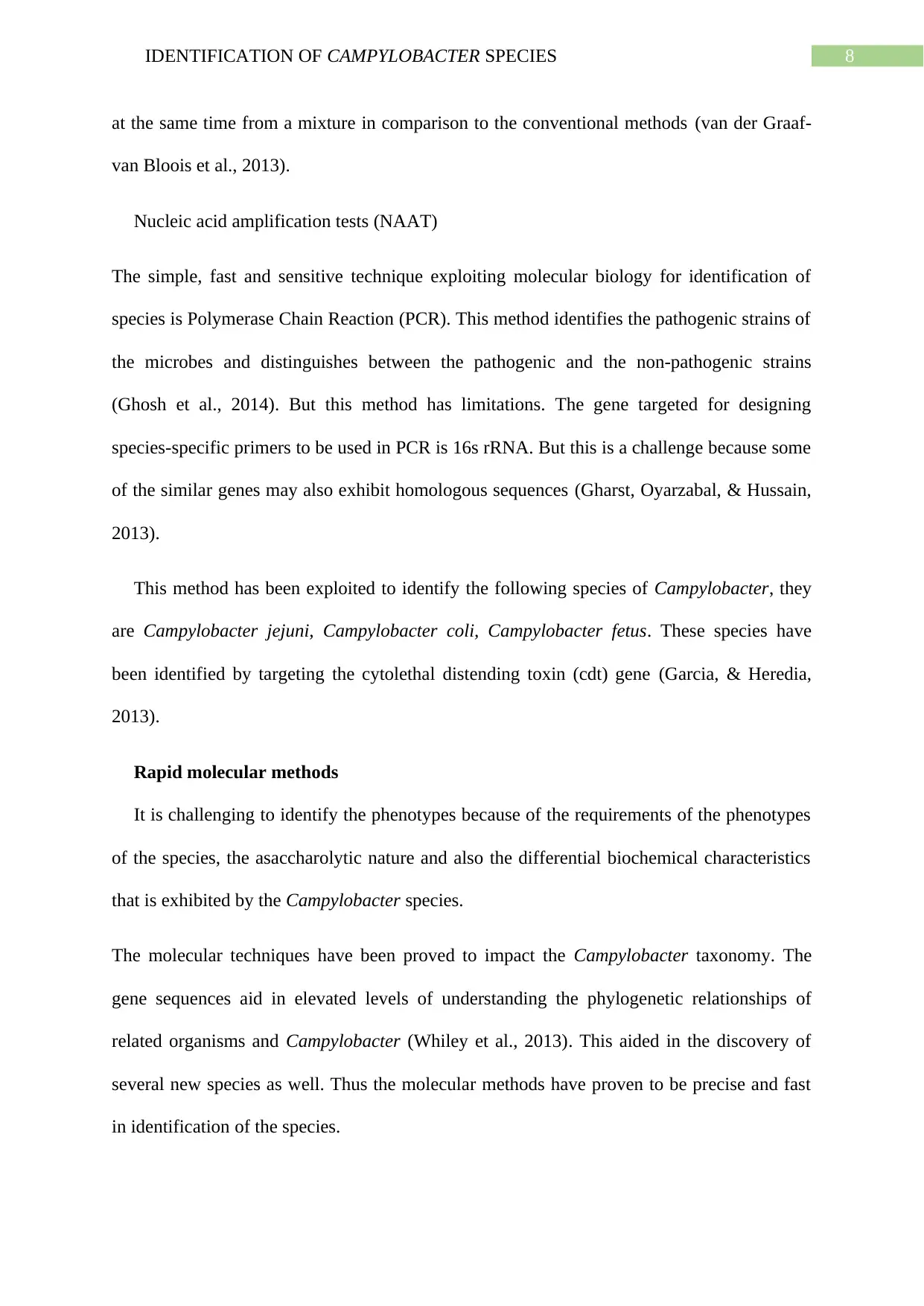
8IDENTIFICATION OF CAMPYLOBACTER SPECIES
at the same time from a mixture in comparison to the conventional methods (van der Graaf-
van Bloois et al., 2013).
Nucleic acid amplification tests (NAAT)
The simple, fast and sensitive technique exploiting molecular biology for identification of
species is Polymerase Chain Reaction (PCR). This method identifies the pathogenic strains of
the microbes and distinguishes between the pathogenic and the non-pathogenic strains
(Ghosh et al., 2014). But this method has limitations. The gene targeted for designing
species-specific primers to be used in PCR is 16s rRNA. But this is a challenge because some
of the similar genes may also exhibit homologous sequences (Gharst, Oyarzabal, & Hussain,
2013).
This method has been exploited to identify the following species of Campylobacter, they
are Campylobacter jejuni, Campylobacter coli, Campylobacter fetus. These species have
been identified by targeting the cytolethal distending toxin (cdt) gene (Garcia, & Heredia,
2013).
Rapid molecular methods
It is challenging to identify the phenotypes because of the requirements of the phenotypes
of the species, the asaccharolytic nature and also the differential biochemical characteristics
that is exhibited by the Campylobacter species.
The molecular techniques have been proved to impact the Campylobacter taxonomy. The
gene sequences aid in elevated levels of understanding the phylogenetic relationships of
related organisms and Campylobacter (Whiley et al., 2013). This aided in the discovery of
several new species as well. Thus the molecular methods have proven to be precise and fast
in identification of the species.
at the same time from a mixture in comparison to the conventional methods (van der Graaf-
van Bloois et al., 2013).
Nucleic acid amplification tests (NAAT)
The simple, fast and sensitive technique exploiting molecular biology for identification of
species is Polymerase Chain Reaction (PCR). This method identifies the pathogenic strains of
the microbes and distinguishes between the pathogenic and the non-pathogenic strains
(Ghosh et al., 2014). But this method has limitations. The gene targeted for designing
species-specific primers to be used in PCR is 16s rRNA. But this is a challenge because some
of the similar genes may also exhibit homologous sequences (Gharst, Oyarzabal, & Hussain,
2013).
This method has been exploited to identify the following species of Campylobacter, they
are Campylobacter jejuni, Campylobacter coli, Campylobacter fetus. These species have
been identified by targeting the cytolethal distending toxin (cdt) gene (Garcia, & Heredia,
2013).
Rapid molecular methods
It is challenging to identify the phenotypes because of the requirements of the phenotypes
of the species, the asaccharolytic nature and also the differential biochemical characteristics
that is exhibited by the Campylobacter species.
The molecular techniques have been proved to impact the Campylobacter taxonomy. The
gene sequences aid in elevated levels of understanding the phylogenetic relationships of
related organisms and Campylobacter (Whiley et al., 2013). This aided in the discovery of
several new species as well. Thus the molecular methods have proven to be precise and fast
in identification of the species.
⊘ This is a preview!⊘
Do you want full access?
Subscribe today to unlock all pages.

Trusted by 1+ million students worldwide
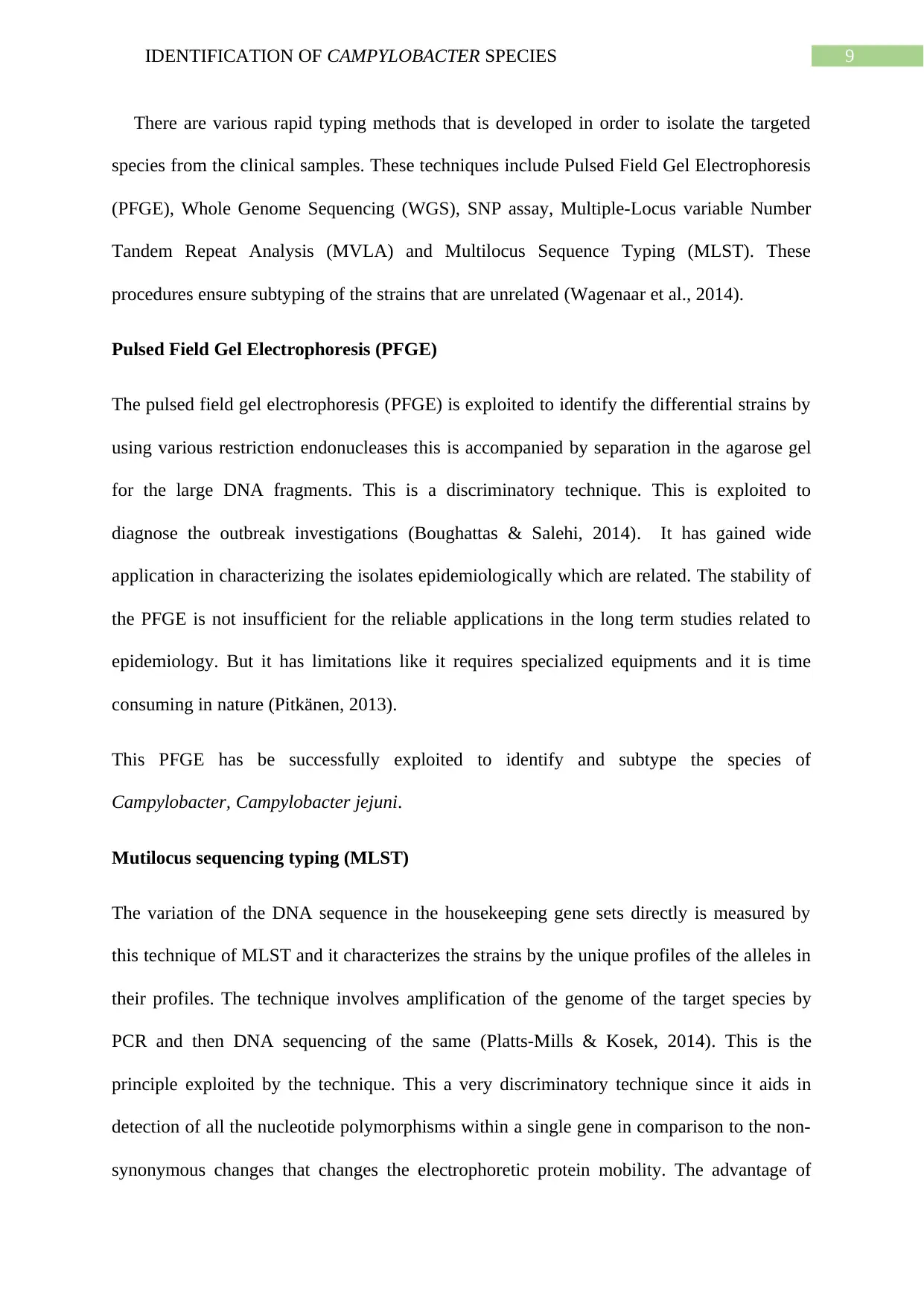
9IDENTIFICATION OF CAMPYLOBACTER SPECIES
There are various rapid typing methods that is developed in order to isolate the targeted
species from the clinical samples. These techniques include Pulsed Field Gel Electrophoresis
(PFGE), Whole Genome Sequencing (WGS), SNP assay, Multiple-Locus variable Number
Tandem Repeat Analysis (MVLA) and Multilocus Sequence Typing (MLST). These
procedures ensure subtyping of the strains that are unrelated (Wagenaar et al., 2014).
Pulsed Field Gel Electrophoresis (PFGE)
The pulsed field gel electrophoresis (PFGE) is exploited to identify the differential strains by
using various restriction endonucleases this is accompanied by separation in the agarose gel
for the large DNA fragments. This is a discriminatory technique. This is exploited to
diagnose the outbreak investigations (Boughattas & Salehi, 2014). It has gained wide
application in characterizing the isolates epidemiologically which are related. The stability of
the PFGE is not insufficient for the reliable applications in the long term studies related to
epidemiology. But it has limitations like it requires specialized equipments and it is time
consuming in nature (Pitkänen, 2013).
This PFGE has be successfully exploited to identify and subtype the species of
Campylobacter, Campylobacter jejuni.
Mutilocus sequencing typing (MLST)
The variation of the DNA sequence in the housekeeping gene sets directly is measured by
this technique of MLST and it characterizes the strains by the unique profiles of the alleles in
their profiles. The technique involves amplification of the genome of the target species by
PCR and then DNA sequencing of the same (Platts-Mills & Kosek, 2014). This is the
principle exploited by the technique. This a very discriminatory technique since it aids in
detection of all the nucleotide polymorphisms within a single gene in comparison to the non-
synonymous changes that changes the electrophoretic protein mobility. The advantage of
There are various rapid typing methods that is developed in order to isolate the targeted
species from the clinical samples. These techniques include Pulsed Field Gel Electrophoresis
(PFGE), Whole Genome Sequencing (WGS), SNP assay, Multiple-Locus variable Number
Tandem Repeat Analysis (MVLA) and Multilocus Sequence Typing (MLST). These
procedures ensure subtyping of the strains that are unrelated (Wagenaar et al., 2014).
Pulsed Field Gel Electrophoresis (PFGE)
The pulsed field gel electrophoresis (PFGE) is exploited to identify the differential strains by
using various restriction endonucleases this is accompanied by separation in the agarose gel
for the large DNA fragments. This is a discriminatory technique. This is exploited to
diagnose the outbreak investigations (Boughattas & Salehi, 2014). It has gained wide
application in characterizing the isolates epidemiologically which are related. The stability of
the PFGE is not insufficient for the reliable applications in the long term studies related to
epidemiology. But it has limitations like it requires specialized equipments and it is time
consuming in nature (Pitkänen, 2013).
This PFGE has be successfully exploited to identify and subtype the species of
Campylobacter, Campylobacter jejuni.
Mutilocus sequencing typing (MLST)
The variation of the DNA sequence in the housekeeping gene sets directly is measured by
this technique of MLST and it characterizes the strains by the unique profiles of the alleles in
their profiles. The technique involves amplification of the genome of the target species by
PCR and then DNA sequencing of the same (Platts-Mills & Kosek, 2014). This is the
principle exploited by the technique. This a very discriminatory technique since it aids in
detection of all the nucleotide polymorphisms within a single gene in comparison to the non-
synonymous changes that changes the electrophoretic protein mobility. The advantage of
Paraphrase This Document
Need a fresh take? Get an instant paraphrase of this document with our AI Paraphraser
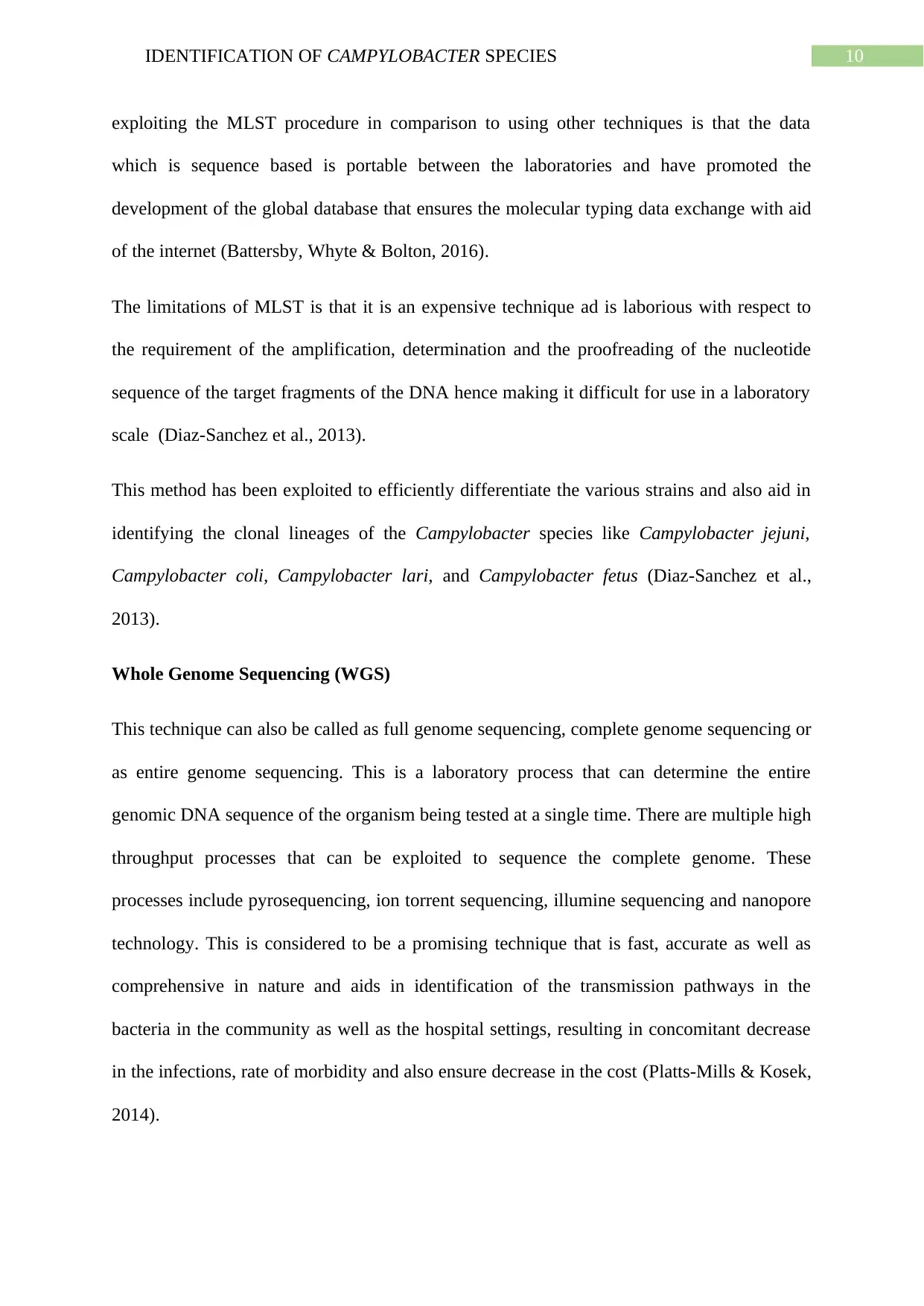
10IDENTIFICATION OF CAMPYLOBACTER SPECIES
exploiting the MLST procedure in comparison to using other techniques is that the data
which is sequence based is portable between the laboratories and have promoted the
development of the global database that ensures the molecular typing data exchange with aid
of the internet (Battersby, Whyte & Bolton, 2016).
The limitations of MLST is that it is an expensive technique ad is laborious with respect to
the requirement of the amplification, determination and the proofreading of the nucleotide
sequence of the target fragments of the DNA hence making it difficult for use in a laboratory
scale (Diaz-Sanchez et al., 2013).
This method has been exploited to efficiently differentiate the various strains and also aid in
identifying the clonal lineages of the Campylobacter species like Campylobacter jejuni,
Campylobacter coli, Campylobacter lari, and Campylobacter fetus (Diaz-Sanchez et al.,
2013).
Whole Genome Sequencing (WGS)
This technique can also be called as full genome sequencing, complete genome sequencing or
as entire genome sequencing. This is a laboratory process that can determine the entire
genomic DNA sequence of the organism being tested at a single time. There are multiple high
throughput processes that can be exploited to sequence the complete genome. These
processes include pyrosequencing, ion torrent sequencing, illumine sequencing and nanopore
technology. This is considered to be a promising technique that is fast, accurate as well as
comprehensive in nature and aids in identification of the transmission pathways in the
bacteria in the community as well as the hospital settings, resulting in concomitant decrease
in the infections, rate of morbidity and also ensure decrease in the cost (Platts-Mills & Kosek,
2014).
exploiting the MLST procedure in comparison to using other techniques is that the data
which is sequence based is portable between the laboratories and have promoted the
development of the global database that ensures the molecular typing data exchange with aid
of the internet (Battersby, Whyte & Bolton, 2016).
The limitations of MLST is that it is an expensive technique ad is laborious with respect to
the requirement of the amplification, determination and the proofreading of the nucleotide
sequence of the target fragments of the DNA hence making it difficult for use in a laboratory
scale (Diaz-Sanchez et al., 2013).
This method has been exploited to efficiently differentiate the various strains and also aid in
identifying the clonal lineages of the Campylobacter species like Campylobacter jejuni,
Campylobacter coli, Campylobacter lari, and Campylobacter fetus (Diaz-Sanchez et al.,
2013).
Whole Genome Sequencing (WGS)
This technique can also be called as full genome sequencing, complete genome sequencing or
as entire genome sequencing. This is a laboratory process that can determine the entire
genomic DNA sequence of the organism being tested at a single time. There are multiple high
throughput processes that can be exploited to sequence the complete genome. These
processes include pyrosequencing, ion torrent sequencing, illumine sequencing and nanopore
technology. This is considered to be a promising technique that is fast, accurate as well as
comprehensive in nature and aids in identification of the transmission pathways in the
bacteria in the community as well as the hospital settings, resulting in concomitant decrease
in the infections, rate of morbidity and also ensure decrease in the cost (Platts-Mills & Kosek,
2014).
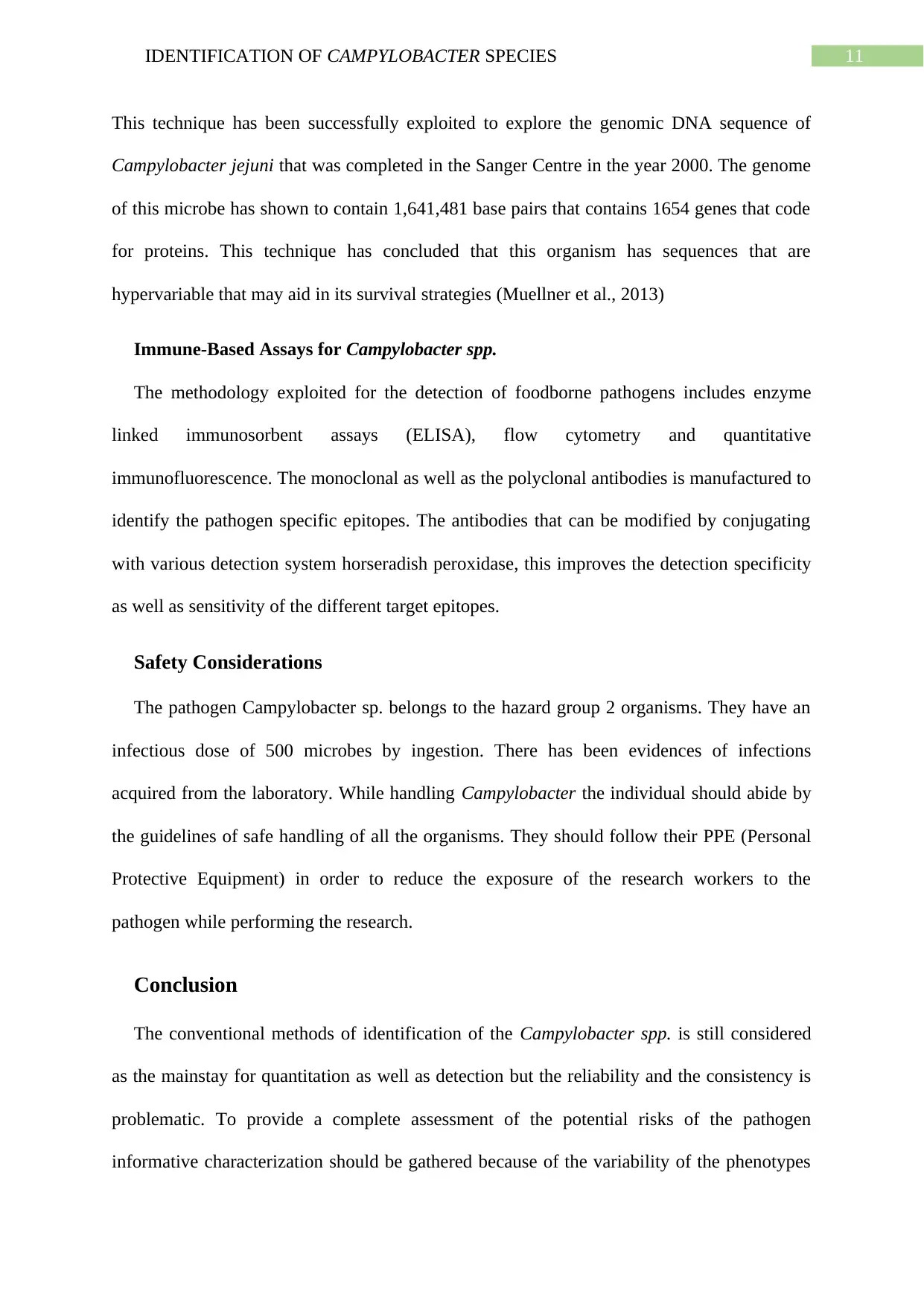
11IDENTIFICATION OF CAMPYLOBACTER SPECIES
This technique has been successfully exploited to explore the genomic DNA sequence of
Campylobacter jejuni that was completed in the Sanger Centre in the year 2000. The genome
of this microbe has shown to contain 1,641,481 base pairs that contains 1654 genes that code
for proteins. This technique has concluded that this organism has sequences that are
hypervariable that may aid in its survival strategies (Muellner et al., 2013)
Immune-Based Assays for Campylobacter spp.
The methodology exploited for the detection of foodborne pathogens includes enzyme
linked immunosorbent assays (ELISA), flow cytometry and quantitative
immunofluorescence. The monoclonal as well as the polyclonal antibodies is manufactured to
identify the pathogen specific epitopes. The antibodies that can be modified by conjugating
with various detection system horseradish peroxidase, this improves the detection specificity
as well as sensitivity of the different target epitopes.
Safety Considerations
The pathogen Campylobacter sp. belongs to the hazard group 2 organisms. They have an
infectious dose of 500 microbes by ingestion. There has been evidences of infections
acquired from the laboratory. While handling Campylobacter the individual should abide by
the guidelines of safe handling of all the organisms. They should follow their PPE (Personal
Protective Equipment) in order to reduce the exposure of the research workers to the
pathogen while performing the research.
Conclusion
The conventional methods of identification of the Campylobacter spp. is still considered
as the mainstay for quantitation as well as detection but the reliability and the consistency is
problematic. To provide a complete assessment of the potential risks of the pathogen
informative characterization should be gathered because of the variability of the phenotypes
This technique has been successfully exploited to explore the genomic DNA sequence of
Campylobacter jejuni that was completed in the Sanger Centre in the year 2000. The genome
of this microbe has shown to contain 1,641,481 base pairs that contains 1654 genes that code
for proteins. This technique has concluded that this organism has sequences that are
hypervariable that may aid in its survival strategies (Muellner et al., 2013)
Immune-Based Assays for Campylobacter spp.
The methodology exploited for the detection of foodborne pathogens includes enzyme
linked immunosorbent assays (ELISA), flow cytometry and quantitative
immunofluorescence. The monoclonal as well as the polyclonal antibodies is manufactured to
identify the pathogen specific epitopes. The antibodies that can be modified by conjugating
with various detection system horseradish peroxidase, this improves the detection specificity
as well as sensitivity of the different target epitopes.
Safety Considerations
The pathogen Campylobacter sp. belongs to the hazard group 2 organisms. They have an
infectious dose of 500 microbes by ingestion. There has been evidences of infections
acquired from the laboratory. While handling Campylobacter the individual should abide by
the guidelines of safe handling of all the organisms. They should follow their PPE (Personal
Protective Equipment) in order to reduce the exposure of the research workers to the
pathogen while performing the research.
Conclusion
The conventional methods of identification of the Campylobacter spp. is still considered
as the mainstay for quantitation as well as detection but the reliability and the consistency is
problematic. To provide a complete assessment of the potential risks of the pathogen
informative characterization should be gathered because of the variability of the phenotypes
⊘ This is a preview!⊘
Do you want full access?
Subscribe today to unlock all pages.

Trusted by 1+ million students worldwide
1 out of 17
Your All-in-One AI-Powered Toolkit for Academic Success.
+13062052269
info@desklib.com
Available 24*7 on WhatsApp / Email
![[object Object]](/_next/static/media/star-bottom.7253800d.svg)
Unlock your academic potential
Copyright © 2020–2025 A2Z Services. All Rights Reserved. Developed and managed by ZUCOL.